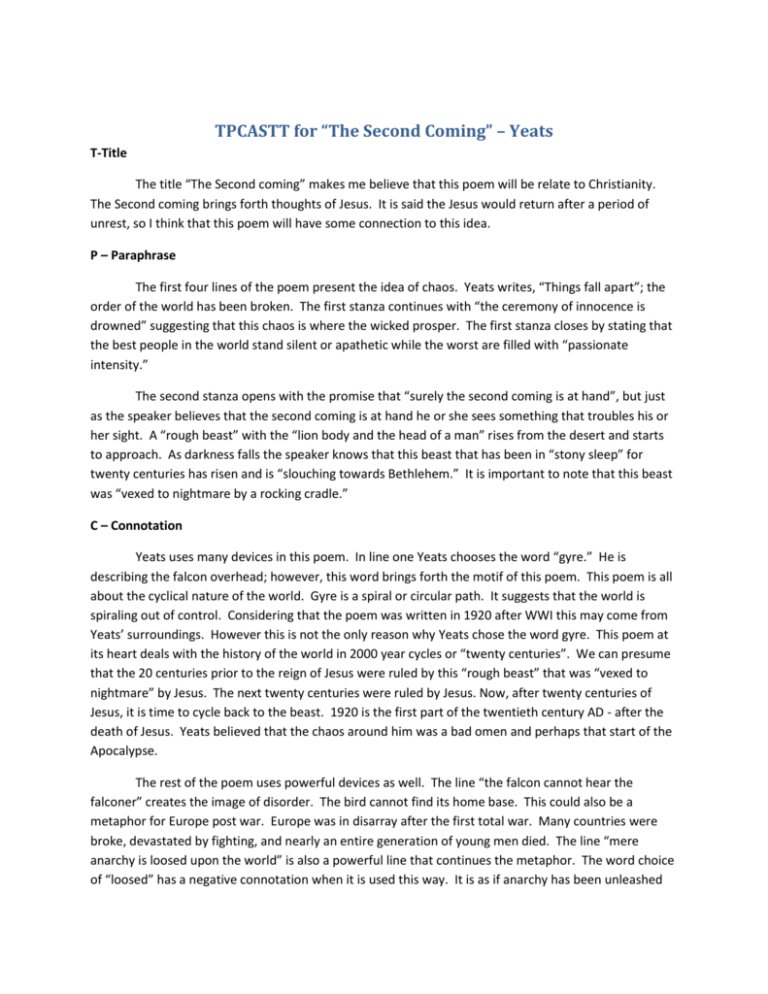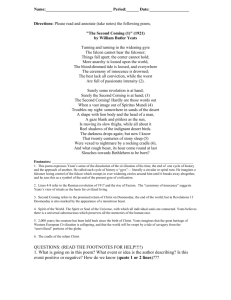TPCASTT for “The Second Coming” – Yeats
advertisement

TPCASTT for “The Second Coming” – Yeats T-Title The title “The Second coming” makes me believe that this poem will be relate to Christianity. The Second coming brings forth thoughts of Jesus. It is said the Jesus would return after a period of unrest, so I think that this poem will have some connection to this idea. P – Paraphrase The first four lines of the poem present the idea of chaos. Yeats writes, “Things fall apart”; the order of the world has been broken. The first stanza continues with “the ceremony of innocence is drowned” suggesting that this chaos is where the wicked prosper. The first stanza closes by stating that the best people in the world stand silent or apathetic while the worst are filled with “passionate intensity.” The second stanza opens with the promise that “surely the second coming is at hand”, but just as the speaker believes that the second coming is at hand he or she sees something that troubles his or her sight. A “rough beast” with the “lion body and the head of a man” rises from the desert and starts to approach. As darkness falls the speaker knows that this beast that has been in “stony sleep” for twenty centuries has risen and is “slouching towards Bethlehem.” It is important to note that this beast was “vexed to nightmare by a rocking cradle.” C – Connotation Yeats uses many devices in this poem. In line one Yeats chooses the word “gyre.” He is describing the falcon overhead; however, this word brings forth the motif of this poem. This poem is all about the cyclical nature of the world. Gyre is a spiral or circular path. It suggests that the world is spiraling out of control. Considering that the poem was written in 1920 after WWI this may come from Yeats’ surroundings. However this is not the only reason why Yeats chose the word gyre. This poem at its heart deals with the history of the world in 2000 year cycles or “twenty centuries”. We can presume that the 20 centuries prior to the reign of Jesus were ruled by this “rough beast” that was “vexed to nightmare” by Jesus. The next twenty centuries were ruled by Jesus. Now, after twenty centuries of Jesus, it is time to cycle back to the beast. 1920 is the first part of the twentieth century AD - after the death of Jesus. Yeats believed that the chaos around him was a bad omen and perhaps that start of the Apocalypse. The rest of the poem uses powerful devices as well. The line “the falcon cannot hear the falconer” creates the image of disorder. The bird cannot find its home base. This could also be a metaphor for Europe post war. Europe was in disarray after the first total war. Many countries were broke, devastated by fighting, and nearly an entire generation of young men died. The line “mere anarchy is loosed upon the world” is also a powerful line that continues the metaphor. The word choice of “loosed” has a negative connotation when it is used this way. It is as if anarchy has been unleashed which then ties to the idea of the rough beast being unleashed upon Europe. “The blood dimmed tide” that washed over is also loosed and “innocence is drowned everywhere.” These two lines have exceedingly dark imagery. The tide of blood drowning the innocent is a truly scary thought. The last two lines of the poem are perhaps the most poetic and eerie. They are eerie because they are truer than Yeats could have known. Yeats writes, “The best lack all conviction, while the worst / are full of passionate intensity.” This line conjures the image of the wicked convincing the masses to the cause because the good are too apathetic to stop them. Yeats could not have known about Hitler, as Hitler was insignificant at the time of the poem; however, Hitler’s passionate intensity and Chamberlain’s (and other politicians) lack of conviction during the early years of Hitler led to the destruction of several million people. The second stanza consists mainly of dark and scary images. The first image is that of “Spiritus Mundi”. Spiritus Mundi is the collective memory of the soul of the world (*side note – read The Alchemist). The speaker sees a collection of symbolic images from the past. The “lion body with the head of a man” refers to the Sphinx which is a mysterious construction next to the Pyramids in Egypt. The Sphynx is an intimidating creature because it has the strength, power and brutality of a lion with the intelligence and capacity for evil of a human. Another interesting device is the “indignant desert” that is witnessing the beast rise. This is an interesting line because it is using personification, but it is also using a very powerful word. Indignant means to show anger over something unjust, so not only is the dessert angry with the rise of the beast, but it also knows that this things is evil or unjust. The poem closes with a rapid-fire assault on the reader. Once the “darkness drops” the beast rises from its twenty centuries of stony sleep, we find that the beast was “vexed to nightmare by a rocking cradle”. This is an obvious reference to baby Jesus 2000 years ago vanquishing the beast to a stony sleep full of nightmares and now the nightmare is just beginning for our world. The age of good is coming to an end as the “rough beast … slouches towards Bethlehem to be born?” We can assume that Yeats is referring to an Antichrist here as Bethlehem is the birthplace of Christ. We can be sure that the Second Coming of Christ is not at hand because Jesus would not be described as someone who “slouches” towards Bethlehem. A – Attitude * my weakest* The best word to describe the attitude of this poem is ominous. The speaker knows that things are falling apart and that something terrible is coming, but is unsure of what exactly to expect, thus the question mark at the end. Yeats uses words that have a primarily negative connotation such as: blooddimmed, pitiless, indignant, darkness, vexed, nightmare, rough, and slouches. These words are all used to create this ominous tone in the poem. Every line in this poem feels negative. The most effective image in the poem is that of the beast slouching towards Bethlehem to be born. The image works because it is visual, kinetic, and auditory. The reader can see the beast slouching and moving towards the manger to be born. The slouching beast that has been asleep for twenty centuries appeals to the reader’s auditory sense as if the reader can hear the stony creature slowly making its way across the wind-swept dessert. S- Shifts There are three shifts in this poem. The first shift is signaled by the change in stanzas. The first stanza is describing the state of the world and has a very pessimistic outlook. The start of the second stanza begins with a more positive outlook. The speaker exclaims, “Surely the Second Coming is at hand. / The Second Coming!” This passage indicates that the speaker believes that the negative things happening in the world are a sign of the second coming of Christ; however, the optimism is short lived. The second shift occurs when the speaker says, “Hardly are those words out / when a vast image … troubles my sight.” At this point the speaker sees the rough beast and realizes that it is not the Second Coming of Christ; rather, something far more sinister. The final shift occurs when the speaker poses the question “what rough beast … slouches towards Bethlehem to be born.” This shift is not a shift in attitude, but more of a question that the speaker does not want answered. T –Theme Although this poem is about some mystical creature vexing the world, it is clear that the poem is an allegory for events happening in Yeats’ life. Yeats and others of his generation saw total war for the first time in history and it deeply disturbed him. In past wars casualty rates were far lower; however, with the invention of new weapons and the lack of adaptation by military command, charging soldiers were cruelly mowed down by machine guns again and again. As the war closed the death did not end. The Spanish flu killed 19 million, the Treaty of Versailles was exceedingly punitive setting the table for the Second World War, inflation crippled the economy, and hundreds of thousands starved to death. There were also rebellions in Russia and Ireland (Yeats’ homeland). The poem is an allegory for the unrest of Europe and fittingly but unfortunately there were several rough beasts that came to power shortly after 1920: Hitler, Stalin, and Mussolini. T – Title At second look the reference to the second coming is not the second coming of Jesus, but the second coming of the antichrist. The time of the beast was 20 centuries before Christ and now we are doomed to suffer for another twenty centuries while we wait for the Age of the Beast to end and Christ’s return.







